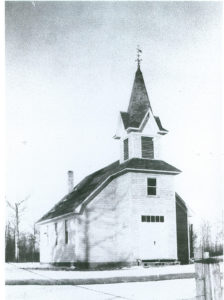How We Became ‘United’
Within the name of United carries the history of three churches that were once active in the Greenbush area. These three — Bethania, Pauli, and Zion — had belonged to a seven-point parish until 1972, when each congregation voted whether or not it would merge with the other churches and establish a new church as a single congregation. Bethania, Pauli, and Zion were the ones who became United, and some individuals from the other four congregations joined them. As these churches came together, funds were combined to set up a new treasury, a call committee was organized to find a pastor, and a vote was taken to determine a new name. Clarice Burkel’s suggestion was the winner: United Free Lutheran, which joined the Association of Free Lutheran Congregations. The ground-breaking ceremony took place April 29, 1973, and the first worship service within the new building occurred Dec. 16 of that year.
“We give glory to God for His answers to our prayers. With His help and our hard work, we pray for many more years of service in Greenbush [and its] surrounding communities.”~ taken from United Free Lutheran’s 25th Anniversary booklet
Below are brief histories of three churches that united.
Bethania

Bethania Free Church, Greenbush, MN
The Bethania congregation was established in 1896 under Pastor J. L. Bestul, gathering in its members’ homes until the church building was constructed in Barto Township (north of Greenbush) in 1901. It was affiliated with the Lutheran Free Church (est. 1897) before joining the Association of Free Lutheran Congregations in 1960s. Around the church’s 30 year anniversary, the congregation purchased and moved into a Methodist church building located within Greenbush city limits. The country church remained in use until being sold in 1944. For several years, Bethania belonged to a four-point parish that included Oiland and Badger Creek in Badger and Emmanuel in Holt. Emmanuel eventually left the parish, but four other churches took its place: Zion, Pauli, Poplar Grove, and Bethlehem. This seven-point parish was served by Pastor Sidney Swenson and Assistant Pastor Burton Rygh, who was also a dairy farmer, until the official merge of 1973, which established United Free Lutheran.

Pauli Church, Dewey Township

Zion Church, Barnett Township
Zion
The Zion Norwegian Evangelical Lutheran Church was organized in the home of Elof Olson in July of 1901. Its pastor, P.C. Birkelo, donated two acres of his homestead in Barnett Township (east of Greenbush) for the construction of a church building and cemetery. The structure was built from hewn logs and clay (later replaced by lime) and did not feature a steeple. It was completed in 1903, around the time Birkelo resigned from serving the congregation. Reverend Nils Njus became pastor shortly thereafter, traveling by horse and buggy between the four other congregations he served and had helped get started. In 1928, the log church was demolished and a new structure was completed in 1935. Zion broke away from the Evangelical Lutheran Church synod in 1957 following the requirement of Evangelical Lutheran churches to merge as one within city limits. Its members later asked to join the Lutheran Free Church seven-point parish under Pastor Swenson. When the Evangelical Lutheran Church and Lutheran Free Church synods decided to consolidate, the seven-point Greenbush parish became one of the founding members of the Association of Free Lutheran Congregations in 1962. Zion did not officially join the AFLC until 1969.